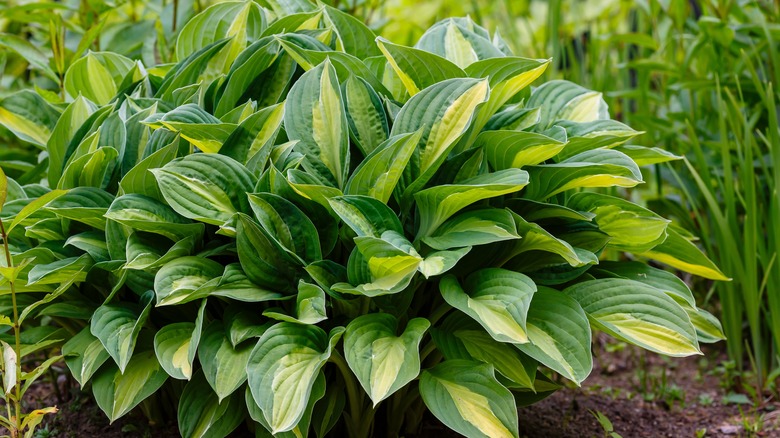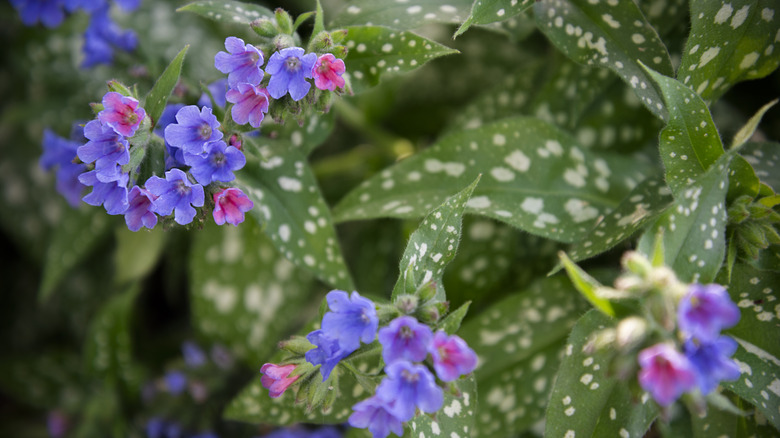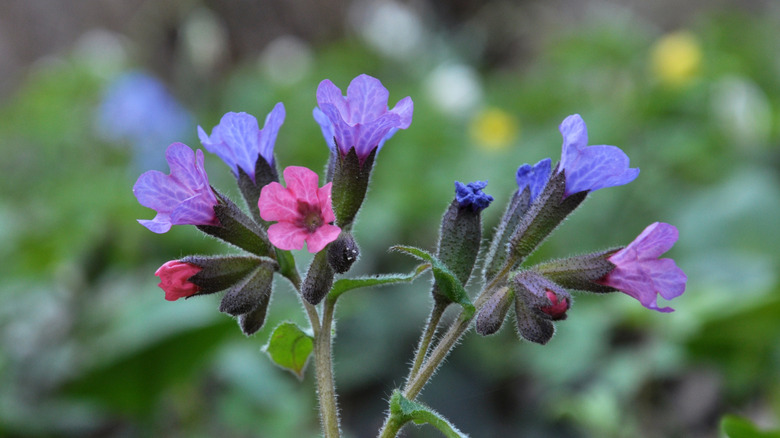The Vibrant Flowering Plant You'll Want To Grow Near Hostas
Hostas are popular garden plants, and with good reason: they're low maintenance, hardy growers and pair well with many other kinds of plants, including spring blooming bulbs and seasonal perennials. Pairing shade-loving perennials with hostas can be a great way to create a dynamic garden design. Lungwort is a perfect match for hostas — it blooms just as hosta leaves begin to increase in size and unfurl their spring growth.
Lungwort (pulmonaria) has grey-green leaves with silvery spots, with some foliage coloring variations depending on the variety. The tiny bell-shaped flowers resemble Virginia bluebells. The flowers range in color from white to blue to purple and often show shades of rosy or carmine pink during their bloom season. Lungwort is a cold-hardy plant (suitable for USDA zones 3-9) that increases every year and looks great planted in clumps of three or four plants spread throughout the semi-shade garden.
Lungwort begins its growth cycle right after the last spring frost and normally grows to a height of between 9 to 18 inches. Its smaller size makes it a great companion to your large hostas or around them. The tiny but colorful blooms, as well as the attractive silver-spotted leaves, add a vibrant spot of beauty during their flowering season. These flowers are also resistant to being nibbled by rabbits or deer.
Planting lungwort
Lungwort is a reliable perennial that requires minimal care. The best time to plant lungwort is in late summer or early autumn to give it time to get established before winter. You can also plant in spring and may be able to find nursery plants that are ready to bloom or already blooming. Plant them in a semi-shady spot; too much shade may cause powdery mildew, and too much sun can dry out their leaves.
This plant likes a loamy, well-draining soil, also preferred by hostas. Many hosta varieties will grow in poor soils like clay, but hard clay soil makes dividing hostas difficult, and well-draining soil allows hostas to get the moisture they need. Access to water and good drainage is important to help all shade perennials thrive and look their best. Lungwort is a somewhat drought-tolerant plant but also needs regular moisture in spring to bloom. Planting it with soil amendments that will help with soil drainage will ensure its well-being and longevity.
Many shade plants prefer a slightly acidic soil, and lungwort is no exception. Peat moss and compost both add some acidity while also helping to improve drainage and add some nutrients to the soil. Used coffee grounds and dried pine needles can also be mixed in to give the soil better texture. This organic matter also improves nutrition and acidity. If you plant your lungwort in good, rich soil, you won't have to worry about fertilizing it during its life cycle.
Regular care and maintenance of lungwort
Your lungwort will normally start to bloom in mid-spring and will produce flowers for several weeks in spring and often until early summer, too. If you're having a dry spring season, be sure to water your lungwort regularly; they need a bit more water during the blooming season. Once your lungwort's flowers start to drop off, you can trip the stems lightly to keep the plants looking neat. This helps encourage new growth and may give you a second round of flowers.
Lungwort's green and silver leaves will normally stay lush throughout the summer and fall. Like many other spring-blooming perennials, lungwort's leaves start to fade and go dormant in late autumn once frost season begins. You may trim them back if you wish or lightly clean them with gloved hands to pull away any dried leaf bits. You can also let the leaves decompose naturally to help feed your garden soil.
The only other care your lungwort needs is regular dividing. Once the plants are established, the rhizome clumps will usually get larger each year. To divide in late summer or fall, simply dig up the clump and gently pull the clump of rhizomes into smaller pieces for planting. Replant these in your semi-shade garden, or share them with gardening friends. If you notice the leaves on your lungwort have been tending to dry out, you may want to move them to a slightly shadier spot.


